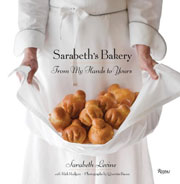
Knowing how to make croissants may or may not already be on your bucket list. Either way, you’re gonna wanna consider making these. They’re not just any croissants. They’re authentically French croissants whose outer layers seem to shatter at the merest glance and whose interior comprises layer after flaky layer of buttery goodness.
Though the recipe may appear quite long, it’s not complicated! It’s just precise. Trust us, when you’re standing at the counter with your sleeves rolled up, your cheeks smudged with flour, and this ridiculously, obscenely, ineffably buttery loveliness coming out of the oven, you’ll understand.–Sarabeth Levine and Rick Rodgers
WHAT IS LAMINATED DOUGH?
Croissants are a little fussier to make than your average pastry and that’s because they’re a laminated dough. Also because they’re French but that’s un autre histoire, bien sur. Layers and layers of butter and dough get folded together and when the heat of the oven hits those layers, the butter melts and the liquid converts to steam, puffing up all those gluten-strengthened layers. Laminated dough is seen in croissants, puff pastry, kouign amann, or palmiers—pastries where you want the lightest and flakiest dough possible. Croissants have the added benefit of yeast, making them even rise higher and giving them a more bread-like finish.

Flaky Croissants
Ingredients
For the detrempe
- 3/4 ounce (1 packed tablespoon plus 1 1/2 packed teaspoons) compressed yeast, or 2 3/4 teaspoons active dry yeast
- 1/4 cup granulated sugar
- 1 1/4 cups whole milk, cold
- 1 3/4 cups bread flour, plus more for rolling out
- 1 1/4 cups pastry or unbleached cake flour, sifted
- 1 teaspoon fine sea salt
For the beurrage
- 2 sticks (8 oz) unsalted butter, chilled and cut into tablespoons
- 2 tablespoons bread flour, plus more for the work surface
For the croissants
- Unbleached all-purpose flour, for rolling
- 1 large egg, well beaten
Instructions
Make the detrempe (a fancy word for dough)
- If using compressed yeast, finely crumble it into the bowl of a heavy-duty standing mixer. Add the sugar and let it rest until the yeast gives off some moisture, about 3 minutes. Whisk well to dissolve the yeast, then stir in the milk. If using active dry yeast, sprinkle the yeast over 1/4 cup of the milk that you've warmed to 105° F to 115° F (40°C to 46°C). Let it rest until the yeast softens and begins to foam, about 5 minutes. Whisk well to dissolve. Pour into the bowl of a heavy-duty stand mixer and then stir in the sugar. Add the remaining 1 cup cold milk.
- Mix the bread and pastry flours together. Add 2 cups of the flour mixture and the salt to the yeast mixture in the bowl. Attach the bowl to the mixer and fit it with the paddle attachment. Mix on low speed, adding enough of the remaining flour mixture as it takes to make a soft, sticky dough. Do not overmix, as the dough will be worked and absorb more flour during the rolling and folding processes.
- Move the dough to a floured work surface and knead a few times to smooth the surface. Shape the dough into a ball. The ball will hold its shape but will spread slightly as it stands.
- Dust a half-sheet pan with flour. Place the dough on the flour and use a small, sharp knife to cut an X about 1-inch (25-mm) deep in the top, marking it into quadrants. Sprinkle the top with a little flour and refrigerate.
Make the beurrage (an equally fancy word for butter)
- Clean the mixer bowl and paddle attachment. Add the butter to the bowl and beat with the paddle attachment on medium speed until the butter is almost smooth, about 30 seconds. Add the flour and continue beating until the mixture is smooth, cool, and malleable, about 30 seconds more. This is your beurrage (beurre = butter in French).
- Transfer the beurrage to a lightly floured work surface and press any remaining lumps of butter out with the heel of your hand. Shape the beurrage into a 4-inch (10-cm) square, place it on the half-sheet pan with the detrempe, and refrigerate for about 15 minutes. The detrempe and the beurrage should be the same consistency and temperature after this slight chilling.
- Flour the work surface again. Place the detrempe on the work surface with the ends of the X at approximately 2, 4, 7, and 10 o'clock positions. You will notice 4 quadrants of dough between the crosses of the X at the north, south, east, and west positions. Dust the top with flour. Using the heel of your hand, flatten and stretch each quadrant out about 2 1/2 inches (7 cm) to make a cloverleaf shape with an area in the center that is thicker than the "leaves."
- Use a rolling pin to roll each "cloverleaf" into a flap about 6-inches (15-cm) long and 5-inches (13-cm) wide, leaving a raised square in the center. Using the side of the rolling pin, press the sides of the raised area to mark the square.
- Place the butter square in the center of the cloverleaf. Gently stretch and pull the north-facing flap of dough down to cover the top and sides of the butter square, brushing away any excess flour. (This dough is very extendable and will stretch easily but you do need to be a little careful not to tear it. If you do, simply try to pat it back together again.)
- Now stretch and pull the south-facing flap up to cover the top and sides of the butter square. Turn the packet so the open ends of the square face north and south. Repeat folding and stretching the north- and south-facing flaps (originally the east and west flaps) to completely cover the butter square, making a butter-filled packet of dough about 6-inches square.
- Dust the work surface with flour. Turn the packet over so the 4 folded flaps face down with the open seam facing you. Dust the top with flour. Using a large, heavy rolling pin held at a slight angle, lightly pound the top to widen it slightly and help distribute the butter inside. Roll the dough into a 17-by-9-inch (43-by-23-cm) rectangle. Fold the dough into thirds, like a business letter, brushing away any excess flour. This is called a single turn. Roll the rectangle lightly to barely compress the layers. Transfer to a half-sheet pan and refrigerate for about 20 minutes.
- Lightly flour the work surface. Place the dough on the work surface with the long open seam facing you. Dust the top with flour. Roll out the dough into a 17-by-9-inch rectangle. Fold the right side of the dough over 2 inches (5 cm) to the left. Fold the left side of the dough over to meet the right side. Fold the dough in half vertically from left to right. This is a double turn (also known as a book turn). Roll the rectangle lightly to barely compress the layers. Return to the half-sheet pan and refrigerate for another 20 minutes.
- Repeat the last rolling and folding into a final single turn. With the long seam facing you, cut the dough in half vertically. Wrap each piece tightly in plastic wrap, then wrap again. Freeze for at least 24 hours or up to 4 days. The night before using the dough, place it in the refrigerator and let thaw overnight, about 8 hours. Once defrosted the dough will begin to rise, so make sure to roll it out immediately.
Roll the dough
- Line 2 half-sheet pans with parchment paper. Dust your work surface with flour. Place the dough on the work surface with the open seam facing you. Dust the top with flour. Using a large, heavy rolling pin, roll out the dough into a 16-by-12-inch (40-by-30-cm) rectangle. Don't press too hard; let the weight of the pin do much of the work. If you change the position of the dough while rolling it, keep track of which side contains the seam.
- Turn the packet so the seam faces you. (If you've lost track, look carefully at the sides of the dough, and you should be able to discern it, even though it's faint.) Using a pizza wheel and a yardstick or rule, neatly trim the rough edges so you have a neat rectangle. Cut in half lengthwise to make two 16-by-6-inch (40-by-15-cm) rectangles. Fold each rectangle into thirds, place on a half-sheet pan, and refrigerate, uncovered, for about 15 minutes.
Cut the croissants
- Remove the dough from the refrigerator. Working with one piece of dough at a time, unfold it on the work surface. Using a pizza wheel and a yardstick, start at the top left corner of the dough and make your way downward diagonally to make a half-triangle with a 2-inch base. Measure 3 1/2-inches (9-cm) from the top left corner of the strip and mark this point with a notch from the wheel. Cut down diagonally from the notch to meet the bottom left edge of the dough strip to make another triangle with a 3 1/2-inch base. Continue cutting, alternating directions of your diagonal cuts, to cut out 6 triangles. The last cut will yield a half-triangle with a 2-inch-wide base. Repeat with the second strip of dough to make 6 more large triangles and 2 half-triangles. You should have a total of 12 large triangles and 4 half-triangles.
Shape the croissants
- (Because a picture says a thousand words, see the slideshow above.) To shape the croissants, place a single "complete" triangle on the work surface with the base of the triangle facing you. Stretch the bottom slightly so it is about 5-inches (13-cm) wide. Pick up the triangle. With one hand, hold the dough triangle at the bottom and stretch it with your other hand until it is about 7-inches (17-cm) long. Return the triangle to the work surface. Starting at the bottom, roll up the triangle, and finish with the tip underneath the croissants on the pan. Curve the croissants by bringing the 2 ends together and then cross one end over the other, and press together. Repeat rolling the remaining dough triangles, placing them 1 1/2-inches (4-cm) apart on the pan. Overlap 2 of the half-triangles at their long sides, and press the seam together. Roll up as described for the large triangles and add to the pan. Repeat with the remaining half-triangles. [Editor's Note: Whew! You made it! Congrats!]
Proof the croissants
- Choose a warm place in the kitchen for proofing. Slip each pan into a tall plastic bag. Place a tall glass of very hot water near the center of each pan. Wave the opening of each bag to trap air and inflate it like a balloon to create “head room,” being sure that the plastic does not touch the delicate dough. Twist each bag closed. Let stand until the croissants look puffy but not quite doubled in size, 1 1/2 to 2 hours.
Bake the croissants
- Meanwhile, position racks in the center and top third of the oven and preheat to 375°F (190°C). Remove the glasses from the bags, then the pans. Lightly brush the croissants with the beaten egg. Bake for 10 minutes. Reduce the heat to 350°F (176°C) and continue baking until the croissants are crisp and golden brown, about 15 minutes longer. Serve the croissants warm or at room temperature.

Nutrition
Nutrition information is automatically calculated, so should only be used as an approximation.
Recipe Testers’ Reviews
After rereading (and rereading) the directions on how to actually shape and mold the dough into flaky croissants, I was brave enough to try it. I thought the flavors were spot on!











Ah, you tease… posting these perfect croissants just as I have puff pastry in the refrigerator. But prefect croissants have long eluded me and I have been searching for the recipe that will give me perfection, so this is one recipe I will try. The photos are perfect, too… I need to see the technique. Thanks to both Sarabeth’s Bakery and LC for giving this to me…
You’re quite welcome, Jamie. And yes, many, many thanks to Sarabeth’s… Signed, The Tease.
These look so unbelievably delicious– i can just imagine them flaking in my mouth… AHHH yum!
Exactly, Lynn! Although thanks to the recipe, you don’t need to just imagine…
I bought her book recently. I’m in love with it. Easily one of the best baking books I own. I’ve never attempted croissants, but this recipe (along with the scene playing in my head of Meryl Streep making chocolate croissants for Steve Martin in “It’s Complicated”) make me want to try!
Beth, yes, that book is a keeper. And I just added that movie to my Netflix queue…many thanks! Meryl Streep is simply a goddess…as is Sarabeth, for that matter.
Indeed! I think we should all get together and bake. Once I come to, after fainting from the awesomeness!
Deal!
I remember it like it was yesterday when Meryl Streeep learned from me to roll the croissant for the movie. She picked up the technique quickly… a natural at everthing. The scenes inside the bakery were shot at Sarabeth’s Bakery. There is a quick moment when you see someone sheeting the dough through our sheeting machine. It’s in slo-mo….that someone is me!
Jump back and get out of town! Really? That’s fantastic. Now I have to rent the move just to see you in slo-mo.
Sarabeth, that’s phenomenal! Who knew?! BTW, I just strolled up to your UWS location and bought a croissant today…
I *own* the movie! Popping it in right now! I didn’t know there was a connection, but I *love* that there is! Makes perfect sense!
Wow! How exciting is that? Yeah, gotta rewatch the movie just to see that!
Yup! I’ve been searching high and low for that clip from the movie, but alas, to no avail…